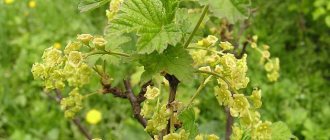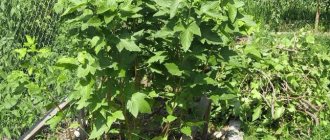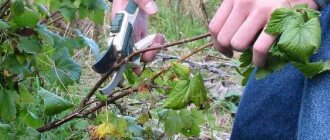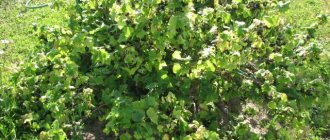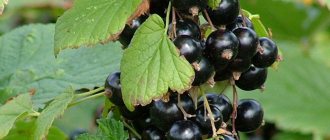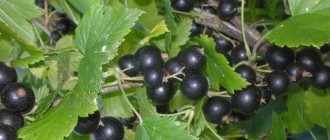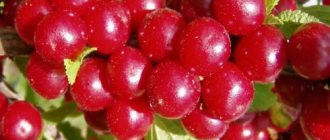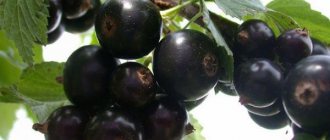Currant Marmaladnitsa was born at the end of the 20th century thanks to the efforts of Bayanova L.V., an employee of the Oryol Institute of Fruit Crop Breeding. The ancestors of the variety were the red currant rootstocks “Rote Spatlese” and “Maarsise Prominente”. The goal of the breeding work was to create a berry bush, the fruits of which would have a high concentration of gelling substances. Test cultivations showed good results, as a result of which an application was submitted to the State Varietal Register for a patent for a red currant variety called “Marmeladnitsa”, which was issued to the institute in December 2001.
The Marmeladnitsa shrub can begin bearing fruit in the first year of planting.
Description of the red currant variety Marmeladnitsa
The seedling belongs to medium-sized plants, has shoots that can reach 1.5 m in height already in the second year of the growing season. An adult plant of red currant Marmeladnitsa has the appearance of a semi-spreading shrub with thick, numerous shoots with barely noticeable and perceptible pubescence.
The leaf blade has a regular five-lobed shape with a wrinkled surface structure and a predominance of rich green color. The marmalade plant is capable of producing a large number of egg-shaped buds.
The resulting flower stalks have a saucer-like appearance. In young bushes, the green color of the receptacle predominates, while in older plants it changes towards a red tint.
Inflorescences appear closer to the beginning of summer (May-June), collected in brushes up to 9 cm long, on which up to 11-12 berries subsequently ripen simultaneously.
The originators of the red currant variety Marmeladnitsa in the patent application indicated the regions for growing the berry - the Central Black Earth Region and some regions of Western Siberia. But numerous reviews from gardeners prove that this variety of red currant successfully grows and bears fruit in other climatic regions of Russia.
Marmalade berries resemble a flattened sphere of a rich orange-red hue with pronounced yellowish veins. The variety has a certain large fruit, as evidenced by the weight of one berry - up to 1 g. The taste of Marmeladnitsa fruits is sweet and sour, which is due to the high content of vitamin C.
Fans of a healthy lifestyle and dietary nutrition should include Marmaladnitsa berries in their daily diet
History of selection and region of breeding
The alma-mother of the variety is the All-Russian Research Institute for Breeding Fruit Crops in the city of Orel.
And the author is Bayanova L.V. This is the result of crossing the German variety Rote Spatlese and Maarsis (Marshal) Promenent.
This variety received its name for its property, namely: the ability to quickly solidify juice even without heating, almost immediately after squeezing.
Variety testing has been taking place since 1996.
Characteristics
The red currant shrub Marmeladnitsa is able to survive the winter well even in the climatic conditions of the Siberian regions, which increases the number of fans of this plant. But this is not the only reason why the variety is so loved not only by amateur gardeners, but also by professional farmers.
Drought resistance, frost resistance
Marmeladnitsa shrubs have good drought resistance, but this does not mean that the variety does not require regular watering and preventive measures.
Important! Inadequate care of Marmeladnitsa currant seedlings will lead to a decrease in the weight of the berries and loss of yield in general.
Speaking about the frost resistance of Marmalade, you need to take into account the growing region:
- The Marmeladnitsa bush easily copes with a drop in the thermometer to -25 oC without taking preventive measures or using covering material.
- The predominance of winter temperatures above - 25 ° C will lead to the need to cover Marmaladnitsa bushes with protective agents.
Based on these factors, we can conclude that the red currant Marmeladnitsa has a high frost resistance rate.
Productivity
The Marmalade bush is classified as a late-ripening variety that begins to bear fruit no earlier than August. The ripening of berries is friendly and plentiful - up to 10 kg of ripe fruit can be collected from one plant per season. Red currant Marmaladenitsa is absolutely not prone to shedding even when overripe, but when picked, the berries are easily separated from the stalk without losing their original appearance.
The harvest of ripe Marmaladnitsa currants is not prone to deformation and dripping during transportation of finished products, even over very long distances.
Red currant Marmaladnitsa is not a heat-resistant variety, so with prolonged exposure to sunlight, some berries may be baked into the bunch, but not more than 10% of the total volume.
Advice! When choosing a place to plant shrubs, you should give preference to an area in partial shade. This will prevent the fruit from baking on very hot summer days.
As the berries ripen, they are not capable of changing shape, size and weight, which guarantees a large harvest of red currants.
Application area
The high content of gelling substances (pectin) in ripe berries puts Marmeladnitsa at the forefront in the production of marmalade, jam and marmalade.
But this is not the only area of application - delicious compotes, jelly and preserves are made from the Marmalade maker.
The variety can also be frozen to please your family with fresh sweet and sour berries in winter. During the defrosting process, the fruits do not deform and do not drain.
It is the red currant Marmaladnitsa that cosmetologists most often use to prepare nourishing masks for the face and hair.
Advantages and disadvantages
The marmalade maker has the following advantages:
- large berry size;
- the ovaries practically do not crumble, which allows you to harvest a good harvest;
- the plant is resistant to sudden temperature changes and can withstand severe frosts;
- is resistant to parasites;
- the berries tolerate heat well even if the bushes are not irrigated for some time;
- tolerates transportation well without changes in appearance;
- contains a large amount of useful substances;
- fruits have good immunity to various diseases;
- The juice of the berries quickly solidifies without freezing.
Disadvantages of the plant:
- due to improper care, the size of the berries changes, the fruits become small;
- bush trunks require special, careful care;
- a large number of shoots are formed on the bush;
- currants require regular fertilization;
- the sour taste of the fruit, which not everyone likes.
Berry composition
The berries of this variety contain the following components:
- ascorbic acid;
- pectin substances;
- vitamins of group B, A, E, PP;
- minerals, which include calcium, magnesium, phosphorus, sodium, potassium.
Such components are present in red currants in large quantities. The chemical composition of the fruit looks like this:
- amount of sugar – 7%;
- acids – 2.2%.
Nutritional value of fruits:
- carbohydrates – 7.5 g;
- proteins – 0.6 g;
- fats – 0.1 gr.
Fruits are among the low-calorie foods. Calorie content is 33.3 kcal per 100 g of berries.
Application
The fruits are suitable for making jam, compote, syrup, juice. However, they are most often used to make jelly. To do this, juice is squeezed out of the fruit, which can be mixed with sugar. This drink freezes on its own. No additional processing required.
The leaves can be used to make tea. This drink increases the body's defenses and stops the inflammatory process. It is especially useful to use it for colds.
The fruits are also widely used in folk cosmetology:
- The berries are recommended for use as masks for the face and body. This product improves the condition of the epidermis, relieving the skin of inflammation and other problems.
- The fruits can be used for hair. They restore the damaged structure of curls, making the strands soft, smooth, and shiny.
- Red currant juice is recommended for use on nails. It strengthens the nail plate, softens the cuticle, which makes manicure easier.
Read about the use of the Shchedraya currant variety at the link.
Medicinal properties
Red currant berries of this variety have the following medicinal properties:
- thin the blood, which prevents excessive clotting;
- free the body from toxic compounds;
- prevent the occurrence of heart attack and stroke;
- have a positive effect on the condition of the heart;
- prevent the development of atherosclerosis;
- increase the body’s defenses, which helps it resist viral and other similar pathologies;
- improve the condition of the visual organs;
- normalize hormonal levels;
- improve the functioning of the digestive system;
- stop the inflammatory process occurring in the body.
Advantages and disadvantages
Despite the late ripening of the red currant variety, gardeners have come to the conclusion that Marmeladnitsa is endowed with more advantages than disadvantages.
The berries left on the bush during the winter gradually dry out and turn into dried fruits
pros
- fleshiness;
- self-fertility;
- large fruit;
- high winter hardiness;
- does not crumble when overripe;
- universal use of ripe berries;
- keeping quality;
- high content of vitamins and minerals;
- resistance to attacks by pathogenic bacteria and insect pests;
- transportability.
Minuses
- rapid formation of new growth;
- the possibility of reducing the yield and size of berries without sufficient attention during cultivation.
Reproduction methods
Red currant variety Marmeladnitsa is reproduced only by layering.
Warning! For rooting you will need one-year-old young shoots.
To obtain new planting material for Marmeladnitsa, you must perform the following procedure:
- Soil preparation. Early spring is the optimal time to start propagating currant bushes. The soil near the seedling must be loosened and organic fertilizers (compost or rotted mullein) applied.
- Soil compaction. Lightly compact the soil in the place where the future redcurrant sprout will take root.
- Digging a small groove 2-3 cm deep. The young shoot will be placed in it.
- Strengthening. To prevent the tree-like shoot from returning to its original position, it will be necessary to secure it with a metal bracket and sprinkle it with soil to a height of 2 cm. In this case, the top must rise above the soil.
- Aftercare. Throughout the summer, the future bush must be hilled, which will help it acquire a well-developed root system.
- Separation of a new seedling from the parent bush. The procedure is carried out in September by cutting off the queen cell.
Healthy and powerful currant seedlings are formed only from layering located in close proximity to the mother plant.
Landing
In the recommended regions, you can start planting new currant bushes at the end of October or beginning of November. For areas related to risky farming, planting dates are shifted to spring (March-April), when the threat of the first spring frosts has passed.
Marmaladnitsa currant bushes are quite demanding on the composition of the soil, so before you start planting, you need to pay attention to the following factors:
- Location of the site. The place should not be located in a lowland where groundwater movement close to the surface is possible. A slightly shaded location, but not in complete shade, is ideal.
- Soil composition. The red currant shrub Marmeladnitsa is very picky about the nutritional value of the soil, therefore, you need to choose an area with a loose, enriched and neutral (PH 6.5-7) substrate.
Having decided on the location, it is necessary to begin preparatory work:
- Digging a hole for planting shrubs, the dimensions of which should not exceed 50 cm (the same parameter for the depth and width of the hole).
- The distance between each hole is from 1.5 to 2 m. This is the optimal size for the location of future bushes, in which they will not interfere with each other during the growing season and development.
- Preparing the nutrient substrate for further placement in the hole. To create it, you need to mix 10 liters of compost, three tablespoons of potassium monophosphate and three glasses of ash. This composition is enough for one currant bush.
- Planting a seedling.
When purchasing, you need to pay attention to the root system. This will be easier to do with seedlings with ACS.
Warning! It is better to purchase seedlings with ZKS at specialized points of sale or fruit nurseries.
Before planting, the bushes must be immersed in a heteroauxin solution for 15 hours.
Before deepening into prepared holes, it is important to carefully straighten the root branches to avoid creases and damage.
Aftercare
Increased growth of shoots can slow down the development of the Marmalade bush and affect the overall yield. This can only be avoided by timely pruning, which, in turn, will eliminate the need for garter.
Proper formation of branches will extend the life of the bush without loss of yield.
Thorough watering and fertilizing are carried out in the evening. This is due to the lower likelihood of evaporation of moisture and nutrients, which are better absorbed at night.
Marmaladnitsa currants do not need shelter for the winter, since they tolerate frost well.
To protect currant seedlings from rodents in the period from November to March, it is enough to hang bells on several bushes. When the wind blows, it makes a sound and noise that can frighten voles and hares.
Rules of care
To ensure full development of currants, it is necessary to properly care for them.
Watering
As a rule, natural precipitation is sufficient for red currants. The crop needs additional watering if there is a summer drought. It is also recommended to moisten the soil when pouring fruit.
It is worth irrigating the beds in the evenings. It is worth pouring 20-30 liters of water under 1 bush. You can also use drip irrigation. To retain moisture, the tree trunk circle should be mulched.
Adding Nutrients
To achieve a bountiful currant harvest, it is recommended to systematically apply fertilizers. In this case, you need to follow the following scheme:
- First half of March. During this period, the plant needs urea. To do this, 25 grams of the product should be mixed with water and watered on the bush.
- Bloom. At this time, the culture requires the use of a solution of bird droppings. It is mixed with water in a ratio of 1:15. The prepared mixture should be watered over the crop.
- Autumn. For the final feeding you will need a mixture of manure and compost. This product is used at intervals of 2-3 years.
See also
Measures to combat rust on currants using folk and chemical means
Read
Pruning and shaping the bush
This plant needs proper bush formation. Therefore, pruning should be regular. The manipulation is carried out until the kidneys appear. This can also be done in the fall. However, in such a situation the plant may not survive the winter well.
To form a bush, do the following:
- In the first year of life, only 5-7 shoots should be left on the currant. The remaining branches should be removed.
- In the second year, 4 branches from last year and 5 new shoots should be left on the bush.
- Next year the bush should have 4 shoots of the first year, 4 branches of the second and the same number of new ones. It is also worth getting rid of dry and broken branches.
In summer, green shoots are pinched. Thanks to this procedure, it is possible to form replacement shoots.
Shelter for the winter
Marmaladnitsa is considered a frost-resistant variety. Therefore, the bushes do not need to be covered. However, in regions with cold winters, the plant still needs insulation. To carry out the procedure correctly, it is recommended to perform the following steps:
- clear the ground around the bush of debris and loosen the soil;
- sprinkle the ground near the plant with sawdust or cover it with spruce branches - the thickness of this layer should be 10 centimeters;
- bend the branches to the ground and fix them in this position - boards are suitable for this;
- wait for the snow or make a shelter with your own hands - for this, the branches are covered with earth or mulch.
Seasonal treatments
Despite its resistance to diseases and pests, Marmalade currant sometimes faces various problems. Seasonal treatments will help cope with them. Common currant lesions include the following:
- Aphid. Insects settle on the underside of the leaves and feed on the sap of the plant. Damage to currants is indicated by swollen spots, yellowing and curling of leaves. The drug Iskra will help to cope with the problem.
- Ognevka. It is a brown butterfly measuring 3 centimeters. The pest eats currant fruits. To get rid of it, the drug Apollo is used before the ovary, after the fruit appears, you can use Karbofos.
- Currant glass. The body of insects is covered with lilac scales. Parasites harm the grapes. To cope with them, Karbofos is used before the buds appear.
- Anthracnose. As the disease develops, brown spots appear on the currants. If the stalk is damaged, the fruits fall off. Cuprozan will help cope with the problem.
- Drying out. When a problem occurs, the protective layer cracks and lumps form. As a result, the shoots die off. Thinning the bushes will help eliminate the disease.
- Rust. The disease leads to the formation of stripes resembling corrosion. Nitrafen will help cope with it.
Pests and diseases
Red-fruited currant Marmaladnitsa is practically not affected by most fungi that can develop on bushes. But even despite these factors, it is better to carry out all preventive measures that will increase the seedling’s resistance to damage by pathogenic fungi and pests.
Marmaladnitsa red currant bushes can reward the gardener with a good harvest only with proper care. Detailed algorithm for processing the red currant bush Marmeladnitsa:
- Bare branches. Abundant watering with boiling water at the end of February will protect the plants from pest invasion.
- Bud opening. Adding ammonium nitrate (2.5 tbsp for each bush).
- Active growth of shoots. Treatment with Topaz fungicide.
- The beginning of flowering. Spraying with iron chelate and boric acid solution (a tablespoon per bucket of water).
- Beginning of fruiting. Carrying out leaf treatment with “Zircon” to protect the bush from heat.
- Preparing for winter. Water the roots with an aqueous suspension of potassium monophosphate (a tablespoon per 10 liters of water) and trim the shoots.
Disease resistance
Marmalade has good immunity to viral diseases and resistance to pests. However, additional processing of the plant will not hurt. This is what poses the greatest danger to red currants:
- Anthracosis. This is a fungal pathology. The disease can be recognized by the brown spots that appear on the leaves. At first they are small in size, but gradually increase in size. Due to this disease, the berries fall off, which negatively affects the amount of harvest. In addition, the pathology leads to the appearance of spots on the fruits themselves. To get rid of the disease, it is recommended to use Cuprozan. Thinning the currants, loosening the soil under the bush, timely clearing the soil of fallen leaves, proper fertilizing and using the furnigicide Topsin-M before the red currants bloom will help to avoid the occurrence of the disease.
- Drying of shoots. This is a fungal disease. Pathology can be recognized by the loss of elasticity of the cortex. As a result, this part of the plant begins to crack. Small protrusions form in the defects, and the branches dry out and over time the shoots die. You can get rid of pathology only by thinning. The occurrence of the disease can only be avoided if the soil is not over-moistened. Drying of shoots can also affect Alpine currants.
- Columnar rust. This is also a fungal pathology. The disease can be recognized by yellow spots on the leaves of the bush. Such defects very quickly change their shade to a red color, which resembles rust. This is where the name of the pathology comes from. To free red currants from pathology, it is recommended to use Nitrofen. The product is used according to the instructions included with the drug.
The following pests can also threaten red currants:
- Aphid. The larvae of this insect reproduce from the bottom of the leaves of the plant and suck out the juice along with useful substances. The following signs help to recognize the presence of a pest: swellings appear on the surface of the leaves. Such defects have a yellow or dark red tint. As a result of the pest's activity, the leaves die and fall off. The drug “Iskra” will help to cope with the problem.
- Ognevka. This is a brown butterfly. This insect is dangerous because it eats berries. Two drugs will help protect the fruits - Apollo and Karbofos. The first remedy is used before the formation of the ovaries, the second - after.
